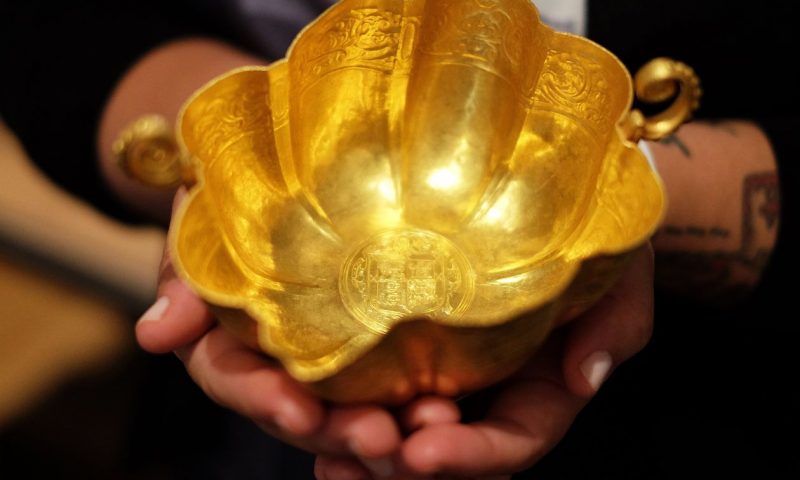Gold futures on Wednesday booked a meager gain, as the precious metal attempted to recover from a series of sharp declines that were prompted partly by progress on vaccines and treatments for the economy-disrupting coronavirus.
Goldman Sachs commodity analyst, including Mikhail Sprogis and Jeffrey Currie, said that a rotation into cyclical, underloved stocks and a lack of substantial moves in inflation have been behind much of the drop for the yellow metal.
“The gold price has corrected sharply in the last two days, now trading close to$1800/toz. The move happened despite 5- and 10-year real rates actually trading lower and weakening of the dollar vs. major gold consumer currencies,” wrote the commodity strategists in a Tuesday report.
“We believe it is due to a combination of pro-cyclical rotation in equities combined with lack of increase in break-even inflation expectations, which drove gold higher in late spring/summer,” the team wrote.
“Therefore, gold suffered from strong rotation without reflation,” Sprogis and Currie said.
On Wednesday, December gold GCZ20, 0.16% GOLD, +0.17% rose 90 cents, or less than 0.1%, to settle at $1,805.50 an ounce, after tumbling 1.8% on Tuesday to mark its lowest settlement since mid July, according to Dow Jones Market Data.
Silver for December delivery SIZ20, 0.36% SI00, 0.36% picked up 6.2 cents, or 0.3%, to end at $23.362 an ounce, following a 1.4% drop in the previous session.
So far this week, gold has declined 3.3%, while silver is down by about 4%, FactSet data show.
On Monday, gold and silver prices took a fresh hit from reports from drugmaker AstraZeneca, who said a late-stage study found that the vaccine it is developing with the University of Oxford had an up to 90% efficacy rate. That news followed similarly upbeat vaccine news from Pfizer and its partner BioNTech, as well as from drugmaker Moderna earlier this month.
Marios Hadjikyriacos, senior analyst at XM, said that gold’s decline came during a period of weakness in the dollar and tepid moves in government bonds which might not bode well for the near-term trajectory for bullion.
Staying in the commodity sphere, gold prices continued to suffer yesterday even though the US dollar was broadly weaker. That is an ominous sign for bullion, which has fallen out of favor on speculation that vaccines imply higher real rates going forward,” he wrote.
The dollar was off 0.3% at 91.953 on Wednesday, near an almost three-year low, and on track for a 0.2% slide on the week, as gauged by the ICE U.S. Dollar Index DXY, -0.07%. A weaker dollar usually encourages buying of bullion by investors because it becomes comparatively cheaper to those using other currencies.
Meanwhile, the 10-year Treasury note TMUBMUSD10Y, 0.885% rate has held fairly steady this week, most recently, yielding 0.88%. Rising rates also can detract from gold demand because precious metals don’t offer a coupon.
For much of the past several months, gold has benefited from a flight to safe-haven assets, amid worries about the pandemic. However, progress on remedies has momentarily overshadowed a renewed surge in coronavirus cases.
Commodity markets didn’t see substantial moves in electronic trade after minutes from the Federal Reserve’s most recent meeting earlier this month were released a half-hour after the settlement for metals on Wednesday.
The minutes indicated that “most” Fed officials want to give clearer guidance to investors about the continuing massive $120 billion bond-buying program, but a “few” participants were reluctant to make changes in the near term given the uncertainty about the economic outlook.
The account of the central bank’s meeting was a part of a swath of economic reports that were pulled forward due to the closure of markets on Thanksgiving Thursday and Black Friday, when financial markets in the U.S. will see early closes. Data included, jobless claims, which showed the number of Americans seeking benefits rose for the second straight week to a five week high. Initial jobless claims increased by a seasonally adjusted 30,000 to 778,000 in the seven days ended Nov. 21, the government said.
Meanwhile, the Commerce Department also reported that inflation softened in October, putting the Fed farther away from its 2% inflation target. The Fed’s preferred measure of inflation, PCE annualized slipped to 1.4% last month from 1.5%.
Metals saw little change on the news.
Elsewhere on Comex, December copper HGZ20, 0.77% added a penny, or 0.3%, to settle at 3.3095 a pound. January platinum PLF21, 0.32% rose $11.50, or 1.2%, to end at $969.80 an ounce, while March palladium PAH21, 1.31%, the new most-active contract, shed $7.10, or 0.3%, to settle at $2,364.70 an ounce.

